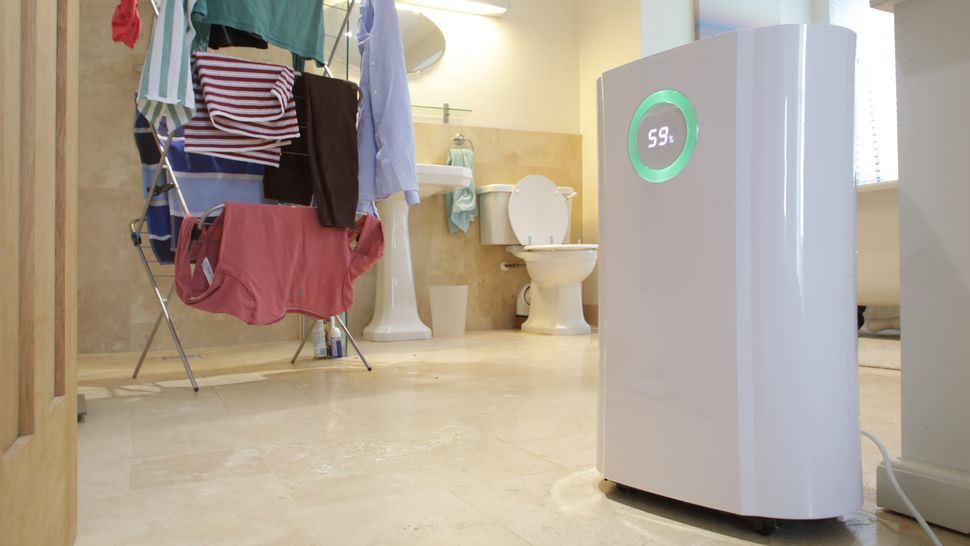Have you ever walked into a room and felt a clammy, musty air clinging to the walls? That’s the telltale sign of excess humidity, and it can be a common problem, especially in multi-story homes. You might wonder, “Do I need a dehumidifier on each floor to combat this?” It’s a valid question, and the answer, much like the humidity itself, depends on a few key factors.

Image: www.homebuilding.co.uk
This article will delve into the world of dehumidifiers and humidity control, specifically addressing the question of whether you need a dehumidifier on every level of your home. We’ll explore the advantages and drawbacks of this approach, consider alternative solutions, and help you make the most informed decision for your unique needs.
Understanding Humidity and Its Impact
Before we dive into the specifics of dehumidifier placement, let’s take a step back and understand why humidity matters. Humidity refers to the amount of moisture in the air. The higher the humidity, the more water vapor is present. While a certain level of humidity is beneficial for human comfort and health, excessive humidity can create a range of problems, including:
- Mold and mildew growth: High humidity creates a breeding ground for these unwelcome organisms, which can cause respiratory problems, allergies, and even structural damage.
- Musty odors: Dampness often leads to unpleasant smells that can linger in your home.
- Increased allergy symptoms: Mold, mildew, and dust mites thrive in humid environments, triggering allergic reactions.
- Damaged furniture and belongings: Moisture can warp wood, damage fabrics, and encourage the growth of mold on your belongings.
- Health concerns: Some studies suggest a link between high humidity and respiratory infections.
Factors Influencing Dehumidifier Placement
Now, let’s address the question of whether you need a dehumidifier on each floor. The answer depends on several crucial factors, including:
1. The Size of Your Home
A larger home, with more square footage, typically requires more dehumidifying power. If your home is expansive, multiple dehumidifiers might be necessary to effectively reduce humidity throughout all areas. However, a smaller house might only need one or two dehumidifiers strategically placed.

Image: www.ohiobasementsystems.com
2. The Level of Humidity
The severity of your humidity problem is crucial. If you experience excessively high humidity levels in specific rooms or on specific floors, such as a basement or bathroom, these areas might benefit from their own dehumidifiers. However, if humidity remains consistently manageable, a single dehumidifier in a central location might suffice.
3. The Construction of Your Home
The materials and layout of your home can significantly impact humidity levels. Older homes, with poorly insulated walls and limited ventilation, often struggle with humidity more than newer, more energy-efficient homes. Consider the construction of your home and its susceptibility to moisture buildup when determining the need for multiple dehumidifiers.
4. Your Budget
Dehumidifiers come in various sizes and price ranges. Weighing the cost of multiple dehumidifiers against the benefits of targeted humidity control is essential for your budget. Remember, a more expensive dehumidifier might provide more powerful and efficient moisture removal, potentially offsetting the need for additional units.
Alternatives to Multiple Dehumidifiers
Before jumping into buying multiple dehumidifiers, explore these alternatives that might address your humidity concerns without the significant investment:
1. Improved Ventilation
Ensuring proper ventilation in your home is crucial for combating humidity. This can involve opening windows and doors for fresh air circulation, but also using exhaust fans in bathrooms, kitchens, and laundry rooms to expel moisture-laden air.
2. Air Conditioning
Air conditioners are effective at lowering humidity along with temperature. While not as powerful as dedicated dehumidifiers, AC units can contribute to a more comfortable environment with lower humidity levels.
3. Moisture-Absorbing Materials
Products like damp rid or silica gel packets can absorb moisture in enclosed spaces like closets, under sinks, or even in your car. These options are helpful for localized humidity control.
4. Dehumidifying Fans
These fans use evaporative cooling to reduce humidity while simultaneously providing airflow. They are more budget-friendly than traditional dehumidifiers but less effective for extreme humidity.
Choosing the Right Dehumidifier
For those who do opt for dehumidifiers, choosing the right model is essential for effective humidity control:
1. Capacity
Dehumidifiers are rated by their capacity (pints per day) to remove moisture. Choose a unit with sufficient capacity for the area you are dehumidifying. For larger spaces or areas with high humidity, a larger dehumidifier is generally required.
2. Features
Dehumidifiers can include various features like automatic humidity control, built-in humidistats, and even timers. Consider your needs and preferences when selecting features.
3. Energy Efficiency
Look for energy-efficient models with an Energy Star rating to minimize your energy consumption and save money.
Do I Need A Dehumidifier On Each Floor
Conclusion
Deciding whether you need a dehumidifier on each floor is a decision based on individual circumstances. Understanding the impact of humidity on your home, the factors influencing humidity levels, and exploring alternative solutions are crucial. By considering these factors and carefully selecting dehumidifiers if necessary, you can create a more comfortable, healthier, and mold-free environment in your home.






